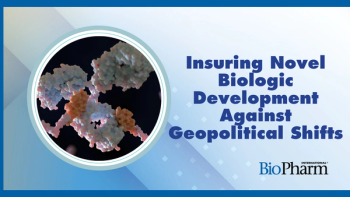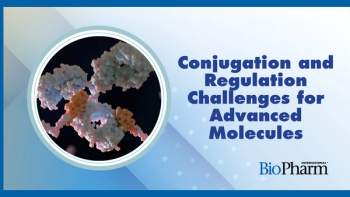
- BioPharm International-01-01-2013
- Volume 26
- Issue 1
Epigenetics Drives Pharma Innovation
Therapeutics targeting epigenetic mechanisms of disease will change the pharmaceutical marketplace.
In the past two decades, epigenetics has grown from an obscure concept applicable mainly to X chromosomal inactivation to one of the dominant driving forces in pharmaceutical R&D (1). Briefly stated, the epigenetic model of regulatory control is based on the observation that half of the structural genes of higher organisms are preceded by CpG islands, clusters of cytosines alternating with guanadines that constitute signaling points that respond to epigenetic signals (2). Modification of these sites through a methylation reaction blocks the transcription of linked genes. Whereas numerous pathological conditions demonstrate an epigenetic connection, progress has been most notable in the field of cancer biology.
K. John Morrow, Jr., PhD
Evidence linking epigenetic modi-fications to the activation of oncogenes or the inactivation of onco-suppressor genes is rapidly coalescing (3). Researchers currently propose a dynamically interactive model by which the genome and epigenome feed back on one another, driving the growth or the involution of tumors (4–6).
This complex model of regulatory control offers many opportunities for a more nuanced understanding of the cancer cell and how it spans the transformation from normal to various stages of malignancy. The new knowledge base opens up possibilities for early diagnosis, because subclinical tumors may release DNA molecules into the circulation that bear highly specific epigenetic modifications defining the type and stage of malignancy of a particular tumor type. These markers can be methylated sites in target genes, and as such, provide a specific and sensitive target. Currently, numerous diagnostic tests for these markers are under development (7).
By the same token, an epigenetic-based therapeutic attack on cancer has been launched. There are a number of basic science teams working with industry to define new epitherapeutics for a range of different cancers.
These changes, affecting both the diagnostic and the therapeutic aspects of oncology, demand a restructuring of our strategies for attacking this disease. There is much interest in other diseases that may have an epigenetic basis, but cancer-based investigation is far advanced over other diseases, so for the next few years this will no doubt be the prime focus of epi-drug development.
New targets call for new strategies for synthesis and production. This may influence the relative balance between small molecules and biological drugs, decisions that will affect the allocation of resources for large-scale production in the coming years. Companies have made decisions in the past reflecting their projected bioprocessing needs, with serious implications for cash flow, so it is crucial that these allocations be assigned on the basis of the best information available.
NEW EPIGENETIC ANTICANCER DRUGS
In addition to the four drugs that have already been approved by FDA (see Table I), a number of new compounds are in clinical trials. Although they are a miniscule component of the current anticancer drug market, their usage is expanding. Cai et al. (2012) have summarized those compounds under scrutiny for use in the treatment of breast cancer (8).
Table I: FDA-approved epigenetic anticancer agents.
Until recently, epigenetic changes had not been recognized as playing a significant role in the origin and progression of cancers. This lack of attention is changing rapidly, as a wealth of research findings are appearing, documenting epigenetic variation and its role in many disease processes. The dominant paradigm, however, has been based on the concept that alterations in DNA base pair sequences are responsible for practically all the variability observed in normal and pathological expression in humans and other living forms.
But the new concept of the origins of cancer is more complete, and proposes an interplay between epigenetic and genetic changes. Baylin and Jones have summarized the history of this movement over the last decade, and they note that there is an emerging view of what has come to be called "the cancer epigenome" (9). The cancer epigenome is essentially a wide collection of abnormalities based on somatically heritable alterations that are not due to primary DNA sequence changes. In fact, the genesis and progression of tumors appears to be a complex process in which DNA-based alterations can favor the development of epigenetic changes, which increase the malignant status of a particular cancer.
The additional layers of complexity introduced by findings in epigenetics are highlighted by Tessema et al., who state that in the past, the main focus was on the damage to the DNA caused by cigarette smoking, but now there is a major concern that epigenetic control molecules may be as important a cause of cancer (10). This more complex mechanism means that an interactive picture will need to be developed which takes into account the feedback between carcinogenic changes in the genome reflecting back to the epigenome, and vice-versa.
The extent of epigenetic damage in cancerous tissue is startling. For example, epigenetic molecules are affected in 60% of patients with pancreatic neuroendocrine tumors. Other molecules are abnormal in 41% of cases of kidney cancer. The aim with epigenetic drugs is to revert those bar codes back to normal, according to Jonathan M. Yingling, vice-president for cancer research at Eli Lilly (11).
EPIGENETICS AND THE BIOPROCESSING INDUSTRY
The epigenetics revolution has arrived at an opportune moment, in which old business models are under siege, and there is an aggressive reassessment taking place within the pharmaceutial industry (12). For years, Big Pharma R&D pursued blockbuster drugs that targeted chronic, widespread conditions requiring pharmaceutical agents to be taken over an extended and indefinite period. Lipitor was the all-time poster child of this strategy, and brought in $70 billion in sales for Pfizer over the course of its patent lifetime. Numerous other drugs developed for the treatment of allergies, high blood pressure, and sexual dysfunction were extremely successful in the marketplace. This model has received a drubbing as year after year R&D costs rose and productivity dropped.
But the rise of epigenetics has introduced a new variable into the equation. All the major pharma companies have epigenetics divisions in place, and some latecomers may not be able to catch up with competitors such as Merck and Novartis. And while the focus is currently on oncology-based drugs, evidence is emerging that many psychiatric disorders have a strong epigenetic contribution (13).
Currently, epigenetics-based drugs are small slice of the large pharma pie. However there are a number of epigenetically targeted compounds in clinical trials, all oncology-based. It is noteworthy that they are all small molecules that will not call for bioprocessing facilities. The global market for one biologic product, monoclonal antibodies, was $44.6 billion in 2011, predicted to grow to $58 billion by 2016. In 2011, epigenetic drug sales were only around $1 billion, but some analysts predict that their growth rate in sales will be much higher, 80 to 100% annualized growth (14).
Of course such predictions come with many caveats, and many factors can intervene in the coming years. The most crucial unknowable is how successful advances in epigenetics research will be in the near future. However, making reasoned assumptions concerning the transformations of the industry driven by the epigenetics revolution, the bioprocessing industry should be prepared to participate in a smaller percentage of the overall oncology drug market.
K. John Morrow, Jr., PhD, is head of Newport Biotechnology Consultants and a member of BioPharm International's editorial advisory board ,
REFERENCES
1. M.E. Donohoe ME. Results Probl. Cell Differ. 55, 231–45 (2012).
2. K. Banno et al., Biochem. Res. Int. onlline, DOI :10.1155/2012/738274 738274, February, 2012.
3. Y. Boumber and J.P. Issa, Oncology 25 (3), 220–228 (2011).
4. P. Lopez-Serra and M. Esteller, Oncogene 31 (13), 1609–1622 (2012).
5. M. Esteller, N. Eng. J. Med. 358, 1148–1159 (2008).
6. P. Ao et al., Med. Hypotheses 70 (3), 678–684 (2008).
7. S.K. Bolta et al., Breast Cancer Res. Treat.135 (3), 705–13 (2012).
8. Cai et al., Int. J. Mol. Sci. 12 (7), 4465–4487 (2012).
9. S.B. Baylin and P.A. Jones, Nat. Rev. Cancer 11 (10), 726–734 (2011).
10. M. Tessema et al., Carcinogenesis 30 (7), 1132–1138 (2009).
11. J.M Yingling JM, "The Changing Field of Drug Development," online Jul. 16, 2012.
12. P. Cuatrecasas, J. Clin. Invest. 116 (11), 2837–2842 (2006).
13. T. Kubota, K. Miyake, and T. Hirasawa, Clin. Epigenetics 4 (1), 1 (2012).
14. K.J. Morrow, Kalorama Reports, Pub ID: KLI3860511, pg. 160 (2012).
Articles in this issue
about 13 years ago
Accelerating Change Marks 2012 for Life Sciencesabout 13 years ago
A Look Ahead at BioPharma Manufacturing and Regulationabout 13 years ago
A Look Ahead in Biomanufacturingabout 13 years ago
Drug Quality at Center Stage for FDA and Manufacturersabout 13 years ago
Falsified Medicines Directive Takes Shape in Europeabout 13 years ago
The Future of Biopharmaabout 13 years ago
Report from Brazilabout 13 years ago
Aseptic Processing: A Primerabout 13 years ago
Biologics: What Does the Future Hold?about 13 years ago
Polishing Complex Therapeutic ProteinsNewsletter
Stay at the forefront of biopharmaceutical innovation—subscribe to BioPharm International for expert insights on drug development, manufacturing, compliance, and more.




